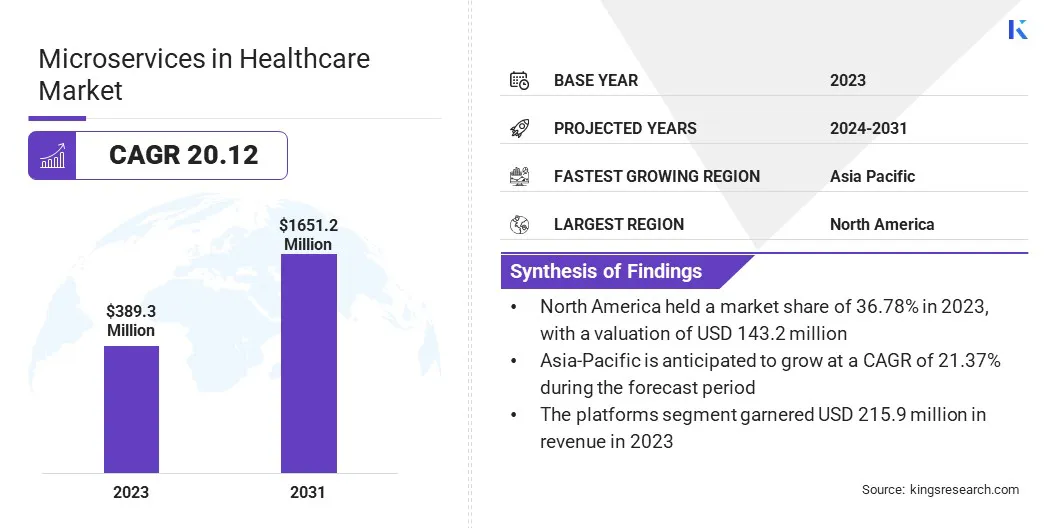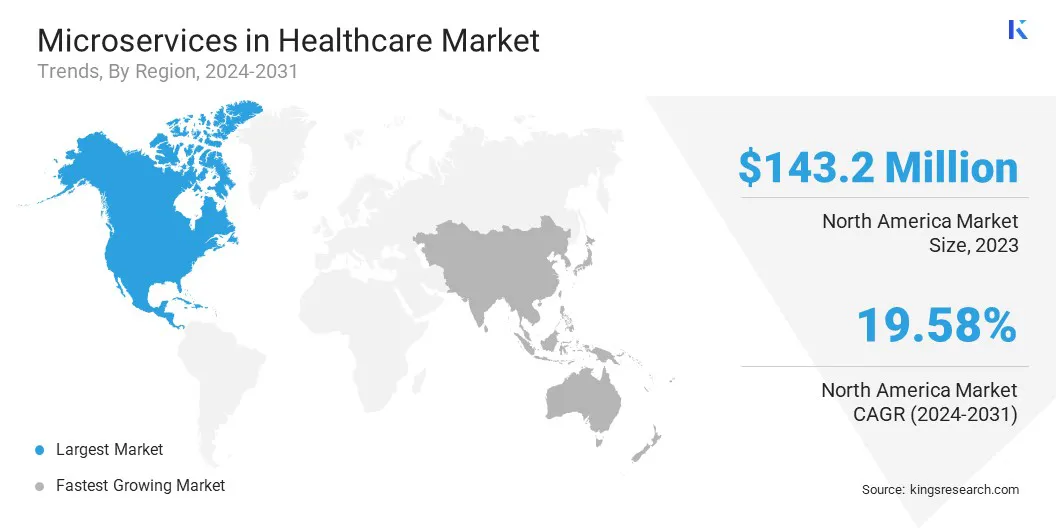Microservices in Healthcare Market Size
The global Microservices in Healthcare Market size was valued at USD 389.3 million in 2023 and is projected to grow from USD 457.6 million in 2024 to USD 1,651.2 million by 2031, exhibiting a CAGR of 20.12% during the forecast period. The market is expanding rapidly, driven by the need for modular, scalable IT solutions in healthcare delivery.
Key factors fueling the market growth include the demand for enhanced operational efficiency, agility in adapting to technological advancements, and improved patient care through specialized service modules like telemedicine and EHR management. Strategic partnerships and the need for regulatory compliance further support market growth, ensuring secure and effective deployment of microservices across diverse healthcare environments.
In the scope of work, the report includes solutions offered by companies such NGINX Inc., Amazon Web Services, Inc., Microsoft, Salesforce.com, Inc., Infosys Limited, IBM, Oracle Corporation, GitHub, Inc., OpenLegacy, TATA Consultancy Services Limited, and others.
The microservices in healthcare market is experiencing rapid growth due to the adoption of modular architectures for enhancing operational efficiency and patient care. These microservices enable healthcare providers to implement flexible and scalable solutions. One such example is specialized modules for telemedicine platforms like appointment scheduling and automated reminders.
This approach supports agile updates and customization, improving the overall service delivery and enhancing user experience. With the increasing adoption of telemedicine, the market demonstrates promising opportunities. Strategic partnerships, regulatory compliance, and ongoing research and development are key factors driving market expansion and innovation in telehealth technologies.
Microservices in healthcare refer to a modular architectural approach where applications are structured as a collection of loosely coupled, independently deployable services. Each microservice handles a specific business function, such as patient scheduling, billing, or electronic health records (EHRs).
These services communicate through well-defined Application Programming Interfaces (APIs), which allows them to operate independently while seamlessly integrating with other services. This architecture enables healthcare providers to achieve scalability, agility, and better operational efficiency by facilitating easier updates, maintenance, and customization of healthcare IT systems.

Analyst’s Review
The integration of microservices into telemedicine platforms, such as dedicated appointment scheduling modules, underscores a strategic approach to enhancing service efficiency and patient experience. By isolating specific functionalities like appointment scheduling as independent microservices, healthcare providers can streamline operations and improve scalability.
This modular architecture enables agile updates and addition of new features, such as automated reminders, without disrupting the entire system.
- According to U.S. Department of Health and Human Services, the significant adoption of telemedicine, highlighted by over 850,000 visits between March 2020 and February 2022, indicates a growing acceptance of virtual care modalities.
The widespread adoption of microservices in telemedicine platforms is poised to further accelerate the shift toward virtual care, enhancing the overall patient experience. As healthcare providers continue to refine their digital offerings, this modular approach ensures that telemedicine solutions remain adaptive, scalable, and responsive to the evolving needs of both patients and providers.
Microservices in Healthcare Market Growth Factors
The growing volume of patient data necessitates scalable and flexible healthcare IT solutions. Traditional systems often struggle with data management, accessibility, and integration, which can lead to inefficiencies. Microservices architecture offers a solution by breaking down complex applications into smaller, manageable services that can be independently developed, deployed, and scaled. This enhances data handling capabilities, improves system reliability, and facilitates faster updates.
Moreover, it promotes better interoperability between healthcare applications. As a result, healthcare providers can efficiently manage and analyze large datasets, streamline operations, and deliver more timely and accurate care, ultimately improving patient outcomes.
Frequent data breaches in healthcare systems are posing significant risks, with each leaked record costing an average of USD 429, as highlighted in a study published in the Journal of Medical Internet Research (JMIR).
According to a Healthcare Information and Management Systems Society (HIMSS) poll, around 68% of healthcare companies identify data security as their primary concern when adopting a new technology. These breaches carry substantial financial burdens due to regulatory fines, legal expenses, and reputational damage, which impedes microservices in healthcare market expansion.
To address these challenges, healthcare organizations are increasingly deploying proactive monitoring systems, real-time threat detection, and rigorous staff training to uphold stringent regulatory standards like HIPAA in the U.S. These efforts aim to enhance cybersecurity resilience, safeguard patient data, and ensure trust within the healthcare sector, crucial for sustaining growth and innovation.
Microservices in Healthcare Market Trends
The seamless integration of diverse applications and data sources, such as EHRs, medical devices, and external services, is driving the growth of the microservices in healthcare market. By enhancing interoperability through well-defined APIs and communication protocols, microservices enable effective data sharing between disparate systems.
This real-time access to comprehensive patient information improves clinical decision-making, patient care, and operational efficiency. The ability to break down information silos and streamline workflows makes microservices an attractive solution for healthcare organizations looking to optimize their IT infrastructure, thus propelling their adoption and expansion in the healthcare sector.
Microservices play a pivotal role in the healthcare sector, where patient data security is critical, by implementing stringent boundaries between services and robust security measures at each level. This decentralized approach reduces the attack surface, minimizing the potential impact of security breaches.
By compartmentalizing services, vulnerabilities in one area do not compromise the entire system, which enhances the overall security and regulatory compliance. This heightened security capability is driving the adoption of microservices in healthcare as organizations prioritize safeguarding sensitive information while improving data management efficiency and maintaining patient trust in an increasingly digital healthcare landscape.
Segmentation Analysis
The global market is segmented based component, delivery model, and geography.
By Component
Based on component, the market is categorized into platforms and services. The platforms segment led the microservices in healthcare market in 2023, reaching a valuation of USD 215.9 million. This segment covers platforms that integrate various healthcare functionalities like EHR management, telemedicine, and patient scheduling into cohesive systems, enhancing operational efficiency and scalability.
By enabling modular architectures and interoperability, platforms facilitate rapid deployment of new services and technologies, fostering innovation. This flexibility effectively meets the current healthcare demands and supports future scalability and adaptability to the evolving healthcare requirements.
As healthcare providers increasingly adopt these advanced platforms, they enhance service delivery, optimize workflows, and ultimately drive market expansion through improved efficiency and patient outcomes.
By Delivery Model
Based on delivery model, the market is divided into on-premises model and cloud-based models. The cloud-based models segment captured the largest microservices in healthcare market share of 20.39% in 2023. Healthcare providers are increasingly adopting cloud-based models to leverage benefits such as on-demand access to resources, reduced infrastructure costs, and enhanced data security.
These models facilitate rapid deployment of microservices, including telemedicine platforms, electronic health records (EHRs) systems, and data analytics tools, thereby improving operational efficiency and patient care delivery. Additionally, cloud-based models support seamless integration across healthcare networks, promoting interoperability and enhancing collaboration among healthcare professionals.
This scalability and accessibility are propelling market growth by enabling healthcare organizations to innovate, expand service offerings, and improve overall healthcare outcomes.
Microservices in Healthcare Market Regional Analysis
Based on region, the global market is classified into North America, Europe, Asia-Pacific, MEA, and Latin America.

North America microservices in healthcare market share stood around 36.78% in 2023 in the global market, with a valuation of USD 143.2 million. The adoption of microservices in the healthcare industry is driven by a robust IT infrastructure, substantial investment in technology, and compliance with stringent regulatory frameworks like HIPAA.
Cloud-based models in this region support seamless integration of diverse healthcare applications, enabling healthcare providers to innovate rapidly and enhance patient care delivery. The region's mature market and high healthcare expenditure further accelerate the adoption of advanced microservice solutions, fostering continuous growth and innovation.
Asia-Pacific is anticipated to witness the significant growth at a CAGR of 21.37% over the forecast period. The region is experiencing rapid adoption of microservices in healthcare, propelled by increasing healthcare digitization, expanding telemedicine services, and growing investment in healthcare IT infrastructure. Further, cloud-based models offer scalability and cost-efficiency, which are crucial in resource-constrained settings across the region.
Regulatory reforms and government initiatives supporting digital healthcare transformation further drive the adoption of microservices, enabling healthcare providers to overcome geographical barriers and improve access to quality healthcare services. This dynamic growth environment positions Asia-Pacific as a key region expansion in healthcare microservices.
Competitive Landscape
The global microservices in healthcare market report will provide valuable insight with an emphasis on the fragmented nature of the industry. Prominent players are focusing on several key business strategies such as partnerships, mergers and acquisitions, product innovations, and joint ventures to expand their product portfolio and increase their market shares across different regions.
Companies are implementing impactful strategic initiatives, such as expanding services, investing in research and development (R&D), establishing new service delivery centers, and optimizing their service delivery processes, which are likely to create new opportunities for market growth.
List of Key Companies in Microservices in Healthcare Market
- NGINX Inc.
- Amazon Web Services, Inc.
- Microsoft
- Salesforce.com, Inc
- Infosys Limited
- IBM
- Oracle Corporation
- GitHub, Inc.
- OpenLegacy
- TATA Consultancy Services Limited
The global microservices in healthcare market is segmented as:
By Component
By Delivery Model
- On-Premises Model
- Cloud-based Models
By Region
- North America
- Europe
- France
- U.K.
- Spain
- Germany
- Italy
- Russia
- Rest of Europe
- Asia-Pacific
- China
- Japan
- India
- South Korea
- Rest of Asia-Pacific
- Middle East & Africa
- GCC
- North Africa
- South Africa
- Rest of Middle East & Africa
- Latin America
- Brazil
- Argentina
- Rest of Latin America


